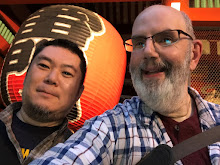aratamebabaa
literally, the old woman who confirms accuracy
For the first time, I will employ a visual aid.
During the Edo Period (1615 to 1867 CE), most women were not allowed to travel freely on their own outside of their community. It was therefore not unheard of for women to dress as men to travel somewhere, or to flee from somewhere.
But if you traveled on any of the main highways that connected cities in Japan (most readers might know of the Tokaido, the route between Edo (now Tokyo) and Kyoto that ran along the coast, but there were many others), you would need to stop at the stations along the route (and there were 53 such stations on the Tokaido between Edo and Kyoto). The shogunate used the stations, known as 関所 sekisyo in Japanese, to check on the movement of goods and people, and at a certain point in history, to check on the gender of travelers. Persons appearing as young men needed to present themselves before an old woman, officially employed by the shogunate, so that she could review the equipment, as it were, and give them leave to travel on.
Imagine putting that on your résumé!
Oh, and let’s have one more look at that old woman, as she peers intently through her eyeglass (optics were introduced by the Dutch):
Thursday, March 12, 2020
Subscribe to:
Post Comments (Atom)



No comments:
Post a Comment